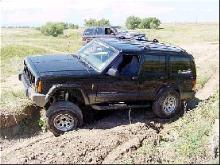
When it comes to equipping your 4x4, the very first article you should purchase for recovery must rate as a snatch recovery strap. (We assume you do own a spade!).
The straps are available at any reputable 4x4-specialist shop and come in a variety of pulling "ratings". Look for a breaking strain of around 9000 kg and at least 9m in length, with a width of around 75mm.
Expect to pay anything between R600 and R1 000 for a decent "brand name" manufactured strap.
At least three "D" shackles should be purchased at the same time, for attaching the strap ends to the vehicle mounting points. Each of the "D" shackles should have a breaking strain of at least 3500 kgs.
A well-equipped off-roader will also purchase at least 2 metres of heavy-duty chain, and perhaps a tree-trunk protector.
When a stuck vehicle is recovered by using a moving vehicle, using a non-tensioned line, we refer to it as a snatch recovery.
If the connecting line were tensioned prior to recovery it would have been referred to as a normal towing operation.
The snatch strap, connecting the two vehicles, has special elastic properties, which allows it to expand by as much as one metre, very much like the workings of an elastic band.
The strap effectively stores kinetic energy released by the momentum of the recovery vehicle. The resultant force is much greater than using a non-expanding towing rope, when the strap returns to its normal length. The snatch strap allows even a small vehicle to recover a much bigger vehicle in a recovery situation.
Remember that on average, a snatch strap is only good for 10 recoveries. It is thus important to always use the stuck vehicle's snatch strap and not your own, owing to the limited life expectancy.
Before attempting to use your snatch strap, ensure that there are no cuts or nicks in the nylon webbing, as even a 1cm tear can reduce the breaking strain by as much as 50%.
Ensure that both vehicles are lined up as straight as possible before commencing recovery. Connect each "eye" of the snatch strap with a "D" shackle to the appropriate mounting points on both vehicles. The snatch strap should be laid out completely flat on the ground, with no twists.
Safety first.
All passengers and bystanders should stand completely clear of the recovery operation at all times. Once a snatch strap is connected to both vehicles, it is viewed as "live" and nobody should be allowed to step over it at any time.
The snatch strap should also never under any circumstances be attached to the towbar of the recovery vehicle. The actual tow-ball could break off and become a fatal bullet to bystanders.
When connecting the snatch strap to the stuck vehicle, it is advisable to spread the load evenly to the front of this vehicle by first attaching the tree trunk protector to both front mounting points before attaching the snatch strap with a "D" shackle.
If any of the vehicles do not come equipped with proper mounting points, create a mounting point by wrapping chain around a suitable area of the chassis. Connect the snatch strap with the help of a "D" shackle to the chain.
Bullbars are not suitable as mounting points for a recovery operation either. The golden rule is that your mounting point should also be directly part of the chassis of both vehicles.
Ensure that there is at least two metres of slack in the snatch strap, before attempting the recovery. Place a towel or blanket over the middle of the snatch strap to act as a "parachute" if any of the mounting points or "D" shackles should fail.
Any rocks, tree trunks or obstacles in the recovery path should be removed beforehand.
The front vehicle should accelerate at moderate speed when "snatching" a stuck vehicle, using preferably low range second gear. The driver of the stuck vehicle should engage the same gear and be ready to release the clutch as exactly the same time as the recovery vehicle.
If this fails to recover the stuck vehicle, repeat the procedure, but this time marginally increase the acceleration speed of the recovery vehicle.
Failing which, increase the amount of slack to 3 metres in the snatch strap!
If the recovery vehicle cannot be brought close enough to the stuck vehicle, for fear of getting bogged down as well, two snatch straps may be connected to each other.
Hook the "eye" of one snatch strap through the "eye" of the second snatch strap and pull a sturdy piece of wood through the protruding loop.
Never use a "D" shackle to connect two snatch straps. It could turn into a lethal missile under strain.
Remember to clean your snatch strap and keep it out of direct sunlight.




 Publications
Publications
 Partners
Partners














